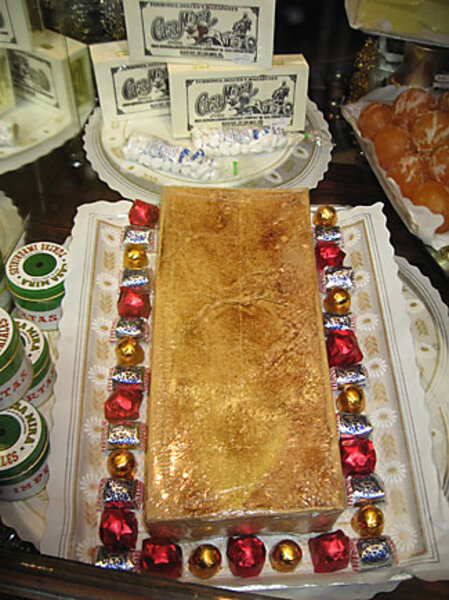A sweet, Spanish Christmas
| Madrid
Here in Spain, nothing heralds the approach of the Christmas season like the stacks of turrón that spring up, seemingly overnight, in supermarket aisles. In the same way that twinkling lights and department store decorations warn Americans that the holidays are nigh, so do towering piles of almond nougat signal to Spaniards that the season is at hand.
When it comes to holiday gastronomy in Spain, it's all about the sugar. In fact, the country is a primary producer and exporter in the world of Christmas sweets.
It's not that Spain has no savory holiday treats. The celebratory season is exceptionally long, beginning Dec. 22, and ending 15 days later with Day of the Kings, the occasion when Spanish children traditionally get their presents. And obviously everyone isn't eating just candy and pastry for those two weeks.
It's true that Christmas is the time when many families invest – and at roughly 400 euros per leg, it is an investment – in a good jamón ibérico, the exquisite ham made from an indigenous breed of pigs that are fed nothing but acorns during their last months.
Most families also come together for a huge, late-night dinner on Christmas Eve that begins with shellfish – langoustines (small lobsters) are a favorite – and culminates in some kind of roast meat, perhaps suckling pig, perhaps turkey stuffed with truffles.
In Catalonia, the northeastern region, canelones – thin sheets of pasta rolled around a meat stuffing and bathed in béchamel – are also a holiday must.
But throughout the country, the season is defined by its sweets. "Turrón, marzipan, mantecados – they're like turkey for Thanksgiving in the US," says Justine Bayod-Espóz, a Spanish-American translator living in Madrid. "They're what everybody eats."
By early in December, Ms. Bayod-Espóz had stocked up on several boxes at Casa Mira, Madrid's most venerable turrón producer. The ornately decorated shop is packed with customers who wait patiently for their turn to step up to the marble counter where a dozen young women in white coats neatly slice off hunks of candy and wrap it carefully in paper.
At Casa Mira, all the turrón is made by hand and "of the very best ingredients," says store manager Amelia Almodóvar. There are some modern versions of the candy – coconut, chocolate, marzipan – but the most popular, she says, are the classics: jijona, which is soft and made from nothing more than ground almonds, honey, and sugar; and alicante, which is hard, thanks to added egg whites, and contains whole almonds.
Both concoctions were first introduced by the Muslims who ruled Spain in the Middle Ages. If anyone sees an irony in their origin and the holiday they're now associated with, they're not saying. "I don't know how turrón became associated with Christmas," says Ms. Almodóvar. "Maybe because almonds are high in calories, and you need calories in the winter to stay warm?"
Mantecados and polvorones are simple cookies made with lard, flour, sugar, and a bit of cinnamon. (Polvorones are dusted with powdered sugar.) Mantecados were traditionally baked by nuns, and indeed, many convents still support themselves by selling the pastries. Historically, the two cookies were associated with Christmas because winter is the season for pig slaughtering, when the lard would be rendered.
If turrón announces the holidays' approach, Roscón de Reyes trumpets their finale. Ring-shaped, and with a consistency somewhere between cake and bread, the roscón (or Three Kings Cake as it is sometimes called in English) is flavored with orange-blossom water and topped with candied fruit and almonds.
Its origins are somewhat mysterious – some experts point to the Romans, others to the French King Louis XV, In Spain, some roscones may come filled with whipped cream or candied squash, but all are served with a prize hidden inside. If your slice contains a tiny figurine, the belief is that you're supposed to have good luck in the coming year; if it contains a dried bean, you have to pay for the roscón.
Although some 2 million roscones were sold last year in Madrid alone, not all were created equally. The Madrid Association of Artisanal Bakers scoffs at industrially produced cakes, and warns that some bakeries might cheat by using simple sweet roll dough, rather than the more complicated traditional recipe. "The best way of knowing if a company makes a good, artisanal roscón," says Esteban Fernández, spokesperson for the association, "is to wait until Jan. 5 and see if they have a line of customers outside."
This year, Bayot-Espóz won't be waiting in line because she'll be back in the US for the holidays. But she's bringing plenty of boxes of sweets with her. Stepping out of the brightly lit Casa Mira into the cold Madrid air, she raises her bag of neatly wrapped turrónes. "It's just not Christmas without them."





